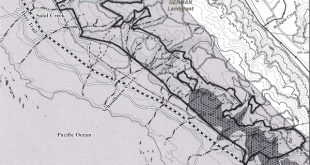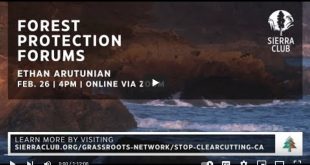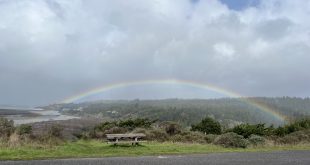Update: The Little THP was approved by the Director of CalFire on September 23, 2021.
Gualala Redwoods Timber has submitted another floodplain logging plan (“Little” THP 1-18-095-MEN), in addition to the disputed Dogwood Timber Harvest Plan (“Dogwood” THP 1-15-042-SON), as well as the “Elk” THP 1-19-00098-MEN.
Friends of Gualala River (FoGR) is especially concerned with these plans to log 90-100 year old redwoods in the floodplain of the Gualala River, because the health of the floodplain is crucial to the over-all ecology of the entire watershed.
FoGR’s list of concerns with the “Little” THP is presented in summary form below, for consideration by any citizen or organization preparing comments on the THP. In addition, we provide links to FoGR’s detailed comments on the “Little” THP, as well as reports on the plan by responsible agencies, reports by hydrologists Greg Kamman and Matt O’Connor, maps of the THP area and the THP documents themselves.
Little THP, 1-18-095-MEN (click to enlarge)
“Little” Timber Harvest Plan, 1-18-095-MEN
Gualala Redwoods Timber has submitted another destructive floodplain timber harvest plan (THP) that would log in the Little North Fork of the Gualala River, in the Doty Creek Planning Watershed (that’s why it’s called “Little” — because it’s in the floodplain of the Little North Fork, not because it’s small; in fact, it’s 199 acres of ‘selection’ logging).
This is a terrible THP for the following reasons:
Over-all concerns
- The Little THP proposes to log in the floodplain in the river. This is a highly sensitive setting, where cool streams have supported Coho salmon in the past, and support Steelhead trout. This area contains the best remaining salmonid habitat in the Gualala River watershed.
- The THP has no reference to any mitigation, monitoring and reporting plan that would blunt the impacts of logging this area and start data collection to properly monitor its cumulative effect with other floodplain logging. Mitigation, monitoring and reporting are particularly needed for all the flood-prone areas of the Little THP. A plan is needed for protection of sensitive fish, wildlife and plants, along with water quality.
- Cumulative impacts are not adequately addressed. The THP fails to describe current, existing conditions, and the potentially significant cumulative impacts on logging in the flood-prone areas of this THP. Since this plan is in a different geographic ‘planning watershed’ than the Dogwood THP, the Forest Practice Rules allow the cumulative effects of both plans to be ignored. This piece-mealing of the impacts of this type of logging on the whole of a sensitive resource base, the floodplain habitat, masks the destructive totality of these step-wise depletions.
- The THP asks for exceptions to standard rules which prohibit use of heavy equipment in flood-prone areas. CAL FIRE’s own rules should preclude the use of heavy equipment in the flood-prone areas of this THP. All of the submitted THPs for floodplain logging in the Gualala River watershed are requesting these exceptions. The exceptions have now become the rule, counter to the intent of the rule-making for these protections.
- This THP fails to provide feasible alternatives for the project. The alternatives analysis should apply the standard rules for Anadromous Salmonid Protections [“ASP Rules”] and flood-prone areas, which require exclusion of heavy equipment operation and avoidance of skid road use in flood-prone areas. What use are the ASP and flood-prone rules if they are set aside, as they are here in the Little THP?
- The Little THP doesn’t include a full map of the flood-prone skid roads. A full map showing the haul roads and skid trails, along with the biological resources in the THP area is needed and should be required.
- The analysis in this THP of flood-prone areas and impacts is deeply flawed at every level.
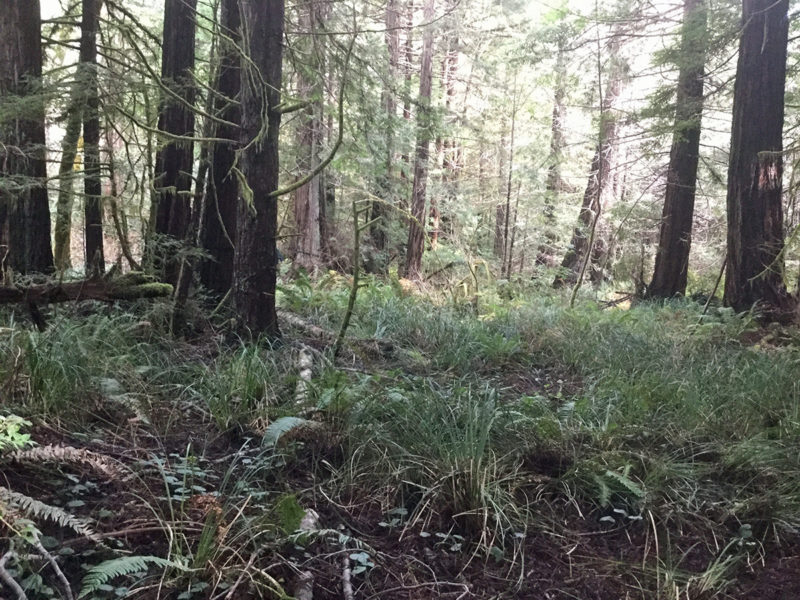
Species-specific concerns
- The Little THP provides no survey data on the Sonoma tree vole, a sensitive wildlife species.
- The THP notes that Western pond turtles may occur there. If heavy equipment is allowed to be used in the flood-prone areas, there will be significant impacts to turtles.
- The THP states there are no Ospreys nesting in the THP area, but there are no survey data or other searches to support this statement. Ospreys do nest in the Gualala River watershed and surveys should be done.
- Where is the survey on Northern spotted owls? The THP says the surveys are not complete. Without the surveys and appropriate mitigation, serious impacts and even deaths could occur.
- A survey is also needed for California red-legged frogs, and Foothill yellow legged frogs, and an appropriate mitigation plan.
- A Vaux’s swift survey is also missing in this THP. A survey for nests, and mitigation if nests are found, needs to be performed.
- A survey of Marbled Murrelets is also absent. Equally absent is a survey of bald eagles or nesting herons.
- A survey of rare plants is also absent. Submitting a list of rare plants that might be there is not a replacement for a scientific survey. The Little THP completely fails to assess existing rare plants, and there is no plan for mitigating damage. A 5-year monitoring plan should be required to assess the impacts of logging in this sensitive area.
Update: The plan has been approved — it is too late to submit comments on this logging plan.

For more information, see:
Little THP plan documents – final, approved versions dated Sept. 23, 2021
In order to make the documents more useful, we have used optical character recognition (OCR) on the documents posted below, so that you can search them.
Little THP Section 1 – Legal Description – [0.4 MB, 7 pages] Cover pages, signatures.
Little THP Section 2 – Operations – [11 MB, 113 pages] Silviculture, Yarding, Erosion Hazard Rating, Winter operations, Roads & landings, Watercourse & lake protections, Alternative Watercourse & lake protections (in lieu of standard rules), Wildlife observances & enforceable provisions, Maps
Little THP Section 3 – Supporting Materials – [2 MB, 28 pages] Stand Descriptions, Water Drafting, Watercourse and lake protection zone roads, landings and skid trails, Alternative watercourse & lake protections (in lieu of standard rules), Analysis of Alternatives
Little THP Section 4 – Cumulative Impacts – [12 MB, 146 pages] Past, present and future projects, assessment of cumulative watershed effects, soil productivity, biological resources, recreational, visual, traffic, noise, greenhouse gas impacts & wildfire risks
Little THP Section 5 – Attachments – [72 MB, 461 pages] Including soil erosion hazards, Erosion Control Plan, stream monitoring reports, Northern Spotted Owl information
Little THP Section 6 – Archeological information – [0.1 MB, 1 pages] (confidential)
Comments by Friends of Gualala River on the “Little” THP (September, 2019)
“On behalf of Friends of Gualala River (FoGR), we are submitting comments on Little THP. FoGR remains concerned that CAL FIRE is preparing yet another THP with disregard for the standards of evidence and reasoned explanation demanded by the California Environmental Quality Act (CEQA). The Little THP includes sensitive riparian redwood (flood-prone) habitat in the last part of the Gualala River watershed known to have supported cool streams with coho salmon, as recently as 2004. The high sensitivity of this environmental setting demands rigorous environmental assessment, equivalent to an Environmental Impact Report required for projects with potential significant impacts…”
Comments by Friends of Gualala River on the “Little” THP (July, 2021)
The following comments are divided into the following topic groupings:
1.) THP Non-Compliance with the Basin Plan and its Non-Point Source NPS Policy
2.) Geological evidence pointing to the need to address NPS Policy in the Basin Plan
3.) Cable Yarding not chosen as a harvesting technique
4.) Inappropriate Requests for Exceptions to the Standard Rules
5.) Inadequacy of the Cumulative Effects Analysis . . .
Comments by Friends of Gualala River on the “Little” THP (August, 2021)
The Regional Water Quality Control Board has failed to demonstrate that the Little THP complies with the requirements of the Timber Harvest WDRs and that the Little THP would not contribute to the existing water quality objective violations and fisheries impairments in the Gualala River watershed.
I have been retained to estimate the sediment yield from surface erosion of roadways and skid trails within and appurtenant to the Little THP and lying within the Little North Fork Gualala River watershed. This letter presents the approach, methods and results of the road and skid trail surface erosion analysis.
Comments by California Native Plant Society on the “Little” THP
“CNPS-DKY is particularly concerned about impact assessment, data, methods, and mitigation for rare plants, wetlands, and sensitive plant communities in the floodplain (including all properly interpreted and delineated “flood prone areas”), resulting mostly from the “exceptions” (“in-lieu practices”) for standard Forest Practice Rules that normally would protect rare plants and sensitive plant communities from severe disturbance or destruction. Standard rules for flood prone areas and Anadromous Salmonid Protection exclude operation of heavy equipment and skid trail use in flood-prone areas of salmonid streams. CAL FIRE has systematically waived these standard rules in each and every THP located in flood-prone areas of the Gualala River watershed…”
PHI Report by the Department of Fish & Wildlife on the “Little” THP
Pre-harvest Inspection Report, THP 1-18-095 MEN, “Little” THP, by the California Department of Fish and Wildlife (CDFW). This report is 69 pages long, to which is appended a 25-page report, “Revised Flood Prone Area Assessment of the Little THP, Mendocino Co. California” (see below). As one of 25 detailed recommendations, the PHI report states, “CDFW recommends the entire valley in the THP be formally delineated as the Flood Prone Area.”
Revised Flood Prone Area Assessment of the Little THP
Attached to the PHI report (above) by the California Department of Fish and Wildlife.
“As per your request, I am providing this memorandum to address a conflict that has arisen between the Gualala Redwood Timber LLC (GRT) and the Caliifornia Department Of Fish and Wildlife (CDFW) regarding environmental protections for “Little” Timber Harvesting Plan (THP) 1-18-095 MEN. The conflict centers around delineating the extent of the “flood prone area” as defined in California’s Forest Practice Rules (FPRs). More specifically, GRT proposes to limit the extent of the Litte North Fork Gualala Rver (Little North Fork) flood prone area to only that part of the valley floor which is inundated by the 20-year recurrence interval flood flow event (20-year floodplain). In contrast, CDFW considers the outer boundary of the flood prone area to be the vallley walls. The difference in areal extent between the 20-year floodplajn versus that of the full width of the valley floor is considerable, so issues associated with habitat protection are potentially significant…”
Technical Assistance letter on “Little” THP by National Marine Fisheries Service
“The purpose of this letter is to provide Technical Assistance to Gualala Redwoods Timberlands (GRT) and California Department of Forestry and Fire Protection (CalFire) from NOAA’s National Marine Fisheries Service (NMFS) for the proposed “Little” timber harvest plan 1-18-095-MEN (Little THP). GRT proposes to harvest redwood trees along the Little North Fork Gualala River (LNFGR) in a manner that is consistent with the California Forest Practice Rules (CFPRs) and that will not adversely affect Endangered Species Act (ESA) listed anadromous salmonids. CalFire and GRT has requested technical assistance from NMFS before approving the Little THP…”
PHI Report by the Water Board on the “Little” THP
Pre-harvest Inspection Report, THP 1-18-095 MEN, “Little” THP, by the North Coast Regional Water Quality Control Board.
The report concludes that “the THP will likely avoid or minimize both short term and long term adverse impacts to beneficial uses of water,” but then, bizarrely, recommends Arundo donax eradication as compensatory mitigation (the only recommendation made). That recommendation was subsequent withdrawn, after learning that the patch of Arundo donax is not growing on GRT’s property but on an adjacent landowner’s property.
‘Focused’ PHI Report by the Water Board on the “Little” THP
“The primary purpose for the focused PHI was for review team members to evaluate issues related to flood prone areas and channel migration zones. Pertinent technical analysis was primarily contained in two reports prepared by O’ Connor Environmental Inc…”
“It is the position of the Regional Water Board that, lacking further hydrologic analysis demonstrating that portions of what appears to be floodplain is not subject to periodic flooding, the floodplain within the Little THP meets the definition of flood prone area and should be designated as such in the THP (Recommendation 1). . .
“It appears likely that without inclusion of the recommendation above, Regional Water Board staff will not be able to make the determination that the THP will avoid or minimize both short term and long-term adverse impacts to beneficial uses of water…”
Unfortunately, this may not have much effect on the environmental impact of the plan, since Cal Fire is apparently allowing an exemption to the ASP rules and allowing road use and heavy equipment in the floodplain (regardless of the exact boundaries of the floodplain).
Comments by hydrologist Greg Kamman on the “Little” THP flood-prone area
“This letter report presents the results of an analysis completed by Kamman Hydrology & Engineering, Inc. (KHE) to determine the flood prone area within the Gualala Redwood Timber, LLC Little Timber Harvest Plan (THP) on the Little North Fork Gualala River upstream of the confluence with the North Fork Gualala River…”
Hydrologic Studies of Little North Fork Gualala River by O’Connor Environmental, Inc.
Three hydrologic studies prepared for Gualala Redwood Timber: (1) Floodplain Study for the Little North Fork Gualala River, (2) Floodplain Inundation Duration Study for the Little North Fork Gualala River, and (3) Channel Migration Zone Evaluation for the Little Timber Harvest Plan, Little North Fork Gualala River, Mendocino County.
Comments by hydrologist Greg Kamman on O’Connor’s reports on the “Little” THP
“I have been retained by Friends of Gualala River (FoGR) to review and evaluate three reports prepared by OEI [O’Connor Environmental, Inc.] on behalf of Gualala Redwood Timber, LLC in support of THP compliance…”
PHI Report by California Geological Survey on the “Little” THP
Pre-harvest Inspection Report provides engineering geologic review of Timber Harvest Plan 1-18-095 MEN.
‘Focused’ PHI Report by Cal Fire on the “Little” THP
Hydrologic and Biologic Review of THP 1-18-095 MEN, “Little” THP, by Pete Cafferata, Watershed Protection Program Manager, Cal Fire Forester III, et al.
“The purpose of this focused PHI and field review was to assess whether the 2019 California Forest Practice Rules (FPRs) are accurately being followed for the Little THP regarding (1) channel migration zone (CMZ) determination, (2) flood prone area determination and protection measures, and (3) potential anadromous fisheries impacts for unconfined reaches of the Little North Fork of the Gualala River.”
[Mr. Cafferata was lead author on the Dept. of Forestry’s 2005 report, Flood Prone Area Considerations in the Coast Redwood Zone.]
PHI Report by Cal Fire on the “Little” THP
Pre-harvest Inspection Report includes a summary of agency recommendations received to date.
All documents regarding the Little THP, including the plan itself, are available in the new CalTREES system.
Unfortunately, CalTREES is not easy to use, so FoGR has compiled some basic instructions for use of CalTREES to help you navigate the new system.
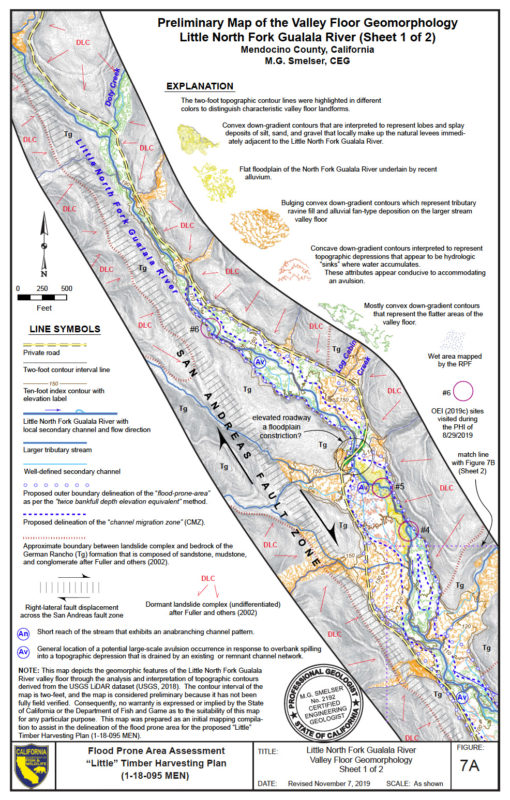
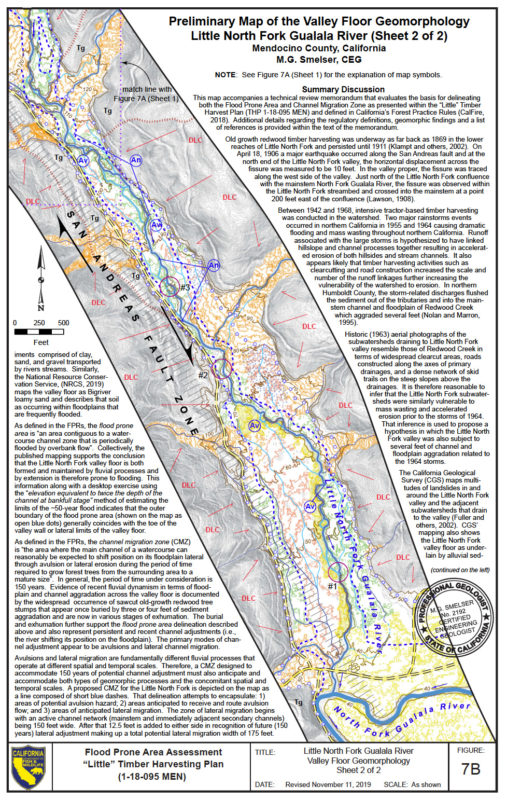
 Friends of Gualala River Protecting the Gualala River watershed and the species living within it
Friends of Gualala River Protecting the Gualala River watershed and the species living within it

